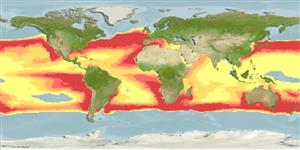Classification / Names
Common names from other countries
Main reference
Size / Weight / Age
Max length : 541 cm TL male/unsexed; (Ref. 10635); 594.0 cm TL (female); max. published weight: 0.00 g; max. reported age: 36 years (Ref. 31395)
Length at first maturity
Lm ?, range 450 - 500 cm
Environment
Marine; brackish; pelagic-oceanic; oceanodromous (Ref. 51243); depth range 0 - 1200 m (Ref. 106604), usually 0 - 250 m (Ref. 55270)
Climate / Range
Subtropical, preferred 25°C (Ref. 107945); 66°N - 58°S, 180°W - 180°E
Distribution
Cosmopolitan, mostly amphitemperate. Western Atlantic: Newfoundland, Canada to Argentina; also north Gulf of Mexico, Bahamas, Cuba and Lesser Antilles (Ref. 26938). Eastern Atlantic: France to South Africa, including the Mediterranean. Indian Ocean: Seychelles, South Africa; also Reunion and Mauritius (Ref. 33390). Western Pacific: Siberia to New Zealand and the Marshall Islands; also south Australia (Ref. 26938). Central Pacific: Hawaii. Eastern Pacific: Alaska to Chile. International trade cooperation, Australia (CITES Appendix III, since 28.5.2003; CMS Appendix I and II).
Countries | FAO areas | Ecosystems | Occurrences | Introductions
Short description
Dorsal
spines
(total): 0;
Dorsal
soft rays
(total): 0;
Anal
spines: 0;
Anal
soft rays: 0. A huge, spindle-shaped shark with conspicuous black eyes, a blunt, conical snout and large, triangular, saw-edged teeth (Ref. 5578). First dorsal-fin origin usually over the pectoral-fin inner margins (Ref. 43278, 6871). Caudal fin crescentic (Ref. 247). Lead-grey to brown or black above, lighter on sides, and abruptly white below (Ref. 6851). Black spot at rear pectoral fin base (Ref. 6851).
IUCN Red List Status (Ref. 115185)
Human uses
Fisheries: minor commercial; gamefish: yes
Tools
Special reports
Download XML
Internet sources
Estimates of some properties based on models
Phylogenetic diversity index
PD50 = 1.0313 many relatives (e.g. carps) 0.5 - 2.0 few relatives (e.g. lungfishes)
Trophic Level
4.5 ±0.4 se; Based on diet studies.
Resilience
Very Low, minimum population doubling time more than 14 years (K=0.06; tm=8-12; tmax=36; Fec=7)
Vulnerability
Very high vulnerability (86 of 100)
Price category
